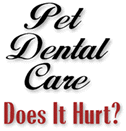


Major pain is obvious. Mandibular and maxillary fractures following acute trauma are generally presented with the animals vocalizing, defensive, and salivating. As with other skeletal fractures pain control is essential when stabilizing and repairing these cases. Soft tissue injury can be very painful following chemical or electrical injury. Acute pulpal exposure is another source of major pain that persists for hours to days then becomes masked. This will be discussed next. Minor pain is a relative term. What seems painful to one animal may be masked and endured by another. The pain is present but may require certain events for it to be manifested. An excellent example is apical disease. This is normally a result of endodontic disease usually from a broken tooth with pulpal exposure. The classic case is a broken upper fourth premolar in a canine. This happens when the dog bites down on a hard object between both carnassial teeth. The mesial cusp of the upper tooth is sheared off exposing the interior pulpal horn. This obviously causes acute pain. The problem is the acute pain subsides in hours to days and becomes masked by the animal. The acute pain subsides because the exposed pulp becomes necrotic and the nerve endings become nonfunctional. Unfortunately, the condition will remain painful for the animal as the inflammation proceeds from the exposed pulp in the cusp to the alveolar bone in the periradicular area. During this phase the animal typically eats, plays and otherwise acts normal. Close observation will reveal the dog avoiding use of the broken tooth and using the healthy areas of its mouth to prehend and eat. The tooth will be sensitive to cold and heat and will bleed through the cusp if the pulp is probed. This testing is not to be done in an awake animal. As the inflammation reaches the apex and periradicular areas the tooth becomes pressure sensitive. At rest the animal is asymptomatic. When loading forces are placed on the tooth it becomes compressed into the alveolus and pain is evoked. This causes the animal not to use the tooth. In time excess plaque and calculus build up on the broken tooth resulting in asymmetry from one side of the mouth to the other. This is almost pathognomonic for local oral pain. Obviously individual pain thresholds vary. Some animals appear stoic with massive injuries and others scream in pain at the thought of a toe nail trim. Masked pain is the type most deceiving to owners and veterinarians. Dogs are pack animals. It has always been in their best interest to hide pain in the pack for fear of displacement in their social standing. Today the family unit is the pack but the evolutionary behavior persists. Also, animals that exhibited pain were consumed by predators because of appearing disabled. Minor pain is easy for animals to mask and since they can't talk to us its easy to overlook this problem. The same principles apply to cats although the species behavior tends to be more territorial than pack. Another facet to the phenomena of masked pain is species survival. For the most part most animals are able to mask and endure their pain through several reproductive cycles. Acute abscesses from endodontic disease take at least six months to a years to become obvious in the canine species thus ensuring at least one reproductive cycle to occur. Other species experience the same delayed manifistation of acute disease. Obviously species survival is a very strong influence on oral pain. Ultimately most oral inflammatory conditions (both hard tissue and soft tissue) become acute and pain becomes major. The pain has always been present, masked or minor but now its obvious. Early intervention will prevent the animals from living with a painful condition for prolonged periods of time.
|